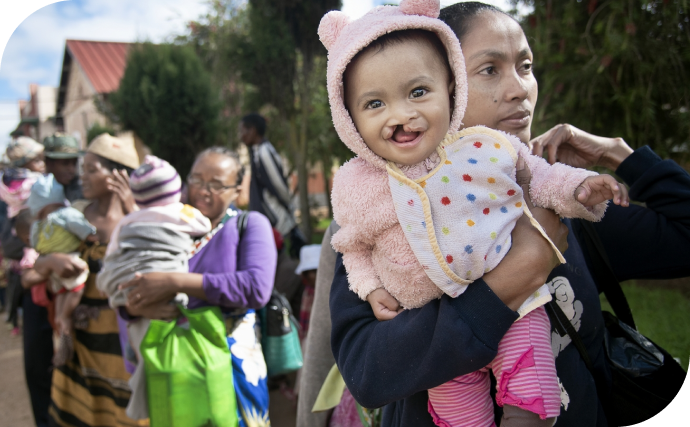WE DID IT!!
Thanks to your generous support, we raised over R100 000 for Operation Smile through the 45 for 45 Smiles Campaign.
It’s a truly fantastic achievement that went far beyond our expectations. We are so grateful and humbled by your response. It means we can plan our next surgical program for early in the new year. More children born with cleft lip or cleft palate will get their brand new smiles, thanks to you.
I was blessed to be present during the recent surgical program, which took place in Mthatha – and it was a life-changing experience.
I felt as if I was floating on a cloud of absolute joy.
From the excitement in the air, the feeling of being part of a group of caring people on a mission to do good to the absolute joy on the faces of mothers who thought their child would have to go through life being ‘different’… from the commitment and care of our volunteer doctors to the way our volunteer nurses put their tiny patients at ease, playing with them and holding on to little hands as they made their way into the operating theatre… to the enthusiasm of the young doctors, eager to learn the skills that will make it possible for them to one day perform this life-changing surgery themselves.
Experience it for yourself by watching this short video. And know that you will be there with us, in spirit, the next time we give a child a brand new smile. Thank you!
Warm regards
Sarah Scarth
Executive Director
Operation Smile South Africa


Operation Smile revolutionized cleft surgery globally in 1982. With nearly four decades of experience as one of the largest surgical volunteer-based nonprofits, Operation Smile staff, its private-public partnerships and thousands of volunteers have improved the health and dignity of patients with cleft conditions, helping them to better breathe, eat, speak and live lives of greater quality and confidence.
While one cleft surgery can transform a child’s life in as little as 45 minutes, Operation Smile is committed to providing patients with health that lasts by being there to offer patients additional surgeries, dentistry, psychological services, speech therapy and other essential cleft treatments. Its training and education programs elevate local surgical standards and entire health systems, aid safe surgery and enable a global network to reach more people earlier in their lives.

A cleft condition is a gap in the mouth that didn’t close during the early stages of pregnancy, and this happens more often than you may realize. It is estimated that, worldwide, a child is born every three minutes with a cleft condition — about one in every 500 to 750 births. Sometimes cleft condition can be easy to see because it’s an opening in the lip. Other times, it’s harder to tell if someone was born with a cleft condition because it’s an opening in the roof of their mouth, which is called the palate.
There are many risk factors that can increase the likelihood of a cleft condition. While some causes are still unknown, genetics and family history, pre-existing medical conditions, poor nutrition and exposure to harmful environmental substances can affect the healthy development of a baby. As a result, these factors could contribute to a baby being born with a cleft lip and/or cleft palate.
While there are still many misconceptions surrounding the causes of cleft conditions, Operation Smile has teamed up with the University of Southern California and Children’s Hospital Los Angeles to conduct the International Family Study (IFS) to better understand why they happen and, hopefully in the future, find a way to ensure that no more people are born with cleft lip and/or cleft palate.
Our IFS research has revealed a potential connection between smoke inhalation from cooking over an open flame and a significant increase in cleft conditions. Stay tuned as we continue to deepen our understanding of the causes of cleft lip and cleft palate.
Depending on the type and severity, a cleft condition can create severe health issues for a child if it’s not treated. It’s common for babies to have difficulty with feeding, which can lead to malnutrition or even starvation. Recurring ear infections can occur, which can lead to hearing loss. Jaw and dental development can also be affected. For people with cleft conditions, especially those with cleft palate, speech and language development can also be hindered. Children may also suffer from bullying and social isolation.
While cleft surgery is vital to ensuring a child will live a happier and healthier life, it acts as only a single step along the path of a patient’s journey toward healing. This is why the comprehensive care we provide patients after surgery at our care centers in countries like Morocco, Colombia and India is essential for the people we serve.
With surgery, a child suffering from cleft lip and/or cleft palate can have a brand-new, beautiful smile. In an ideal situation, a pediatrician and a reconstructive plastic surgeon work with a child’s parents soon after the child’s birth to choose the best timing for surgery. Most surgeons agree that a cleft lip should be repaired by the time a baby is 3 months old, and a cleft palate should be repaired between the ages of 12 and 18 months. Several subsequent surgeries may also be required throughout one’s childhood and adolescence.
But for many of the patients and families we serve in low- and middle-income countries, early surgical intervention isn’t an option due to lack of financial resources, access to qualified medical staff and other factors. Operation Smile remains dedicated to finding these families around the world and providing them with surgery and ongoing care earlier in life so that they can live happier and healthier lives.